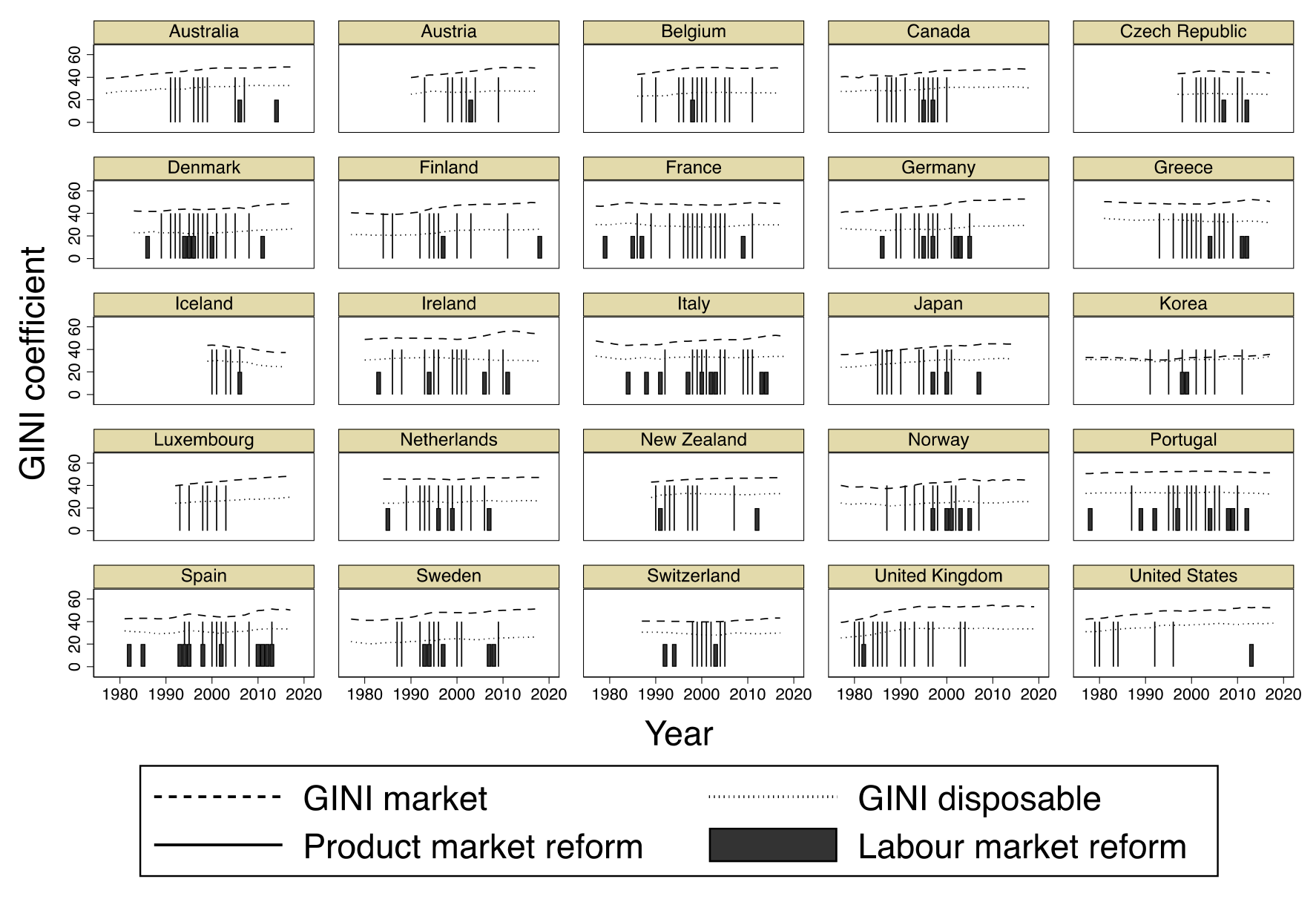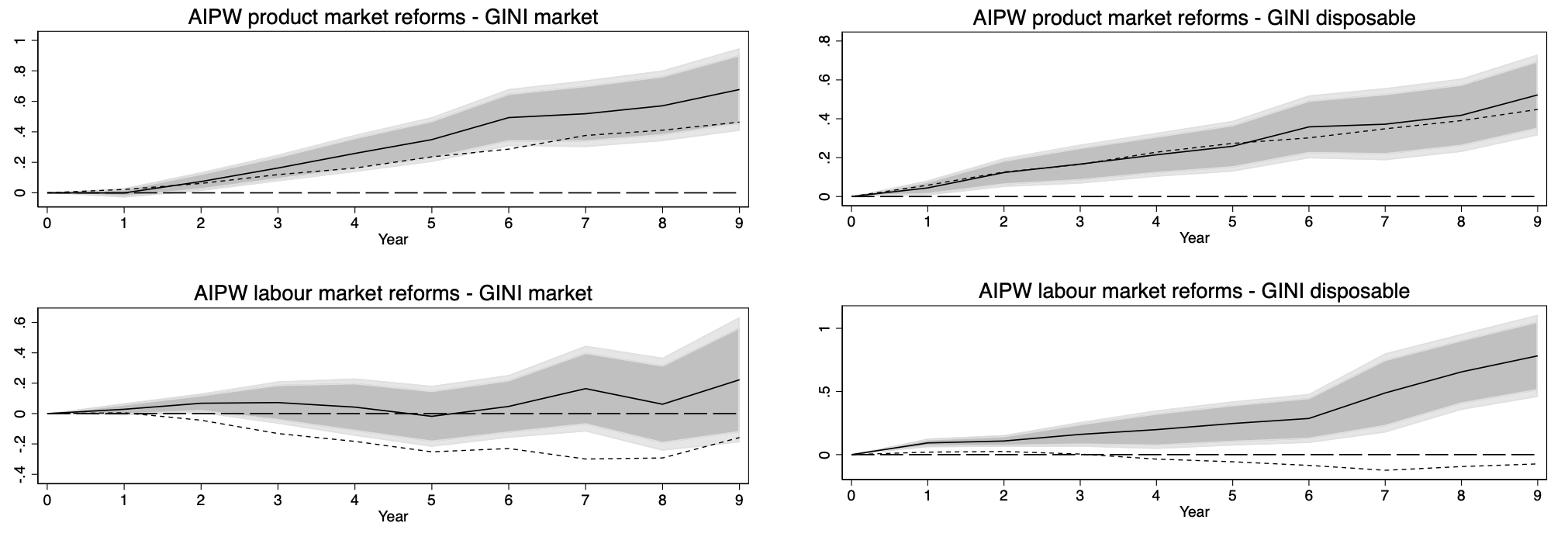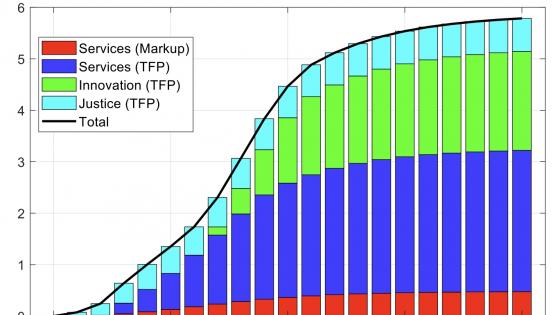Structural reforms are widely believed to enhance economic growth. However, little is known about the effect of structural reforms on the income distribution. If market-oriented reforms lead to increasing inequality, they may subsequently reduce economic growth. Empirical evidence suggests that inequality is associated with slower and less durable economic growth in the medium and long run (see Cerra et al. 2021 for a survey). Recent research suggests that product and labour market reforms may increase income inequality in the short and medium run in OECD countries. When policymakers do not compensate those who lose from these reforms, they may be confronted with a political backlash and social instability because of market liberalisations and their effects on income inequality.
The growth effects of market reforms: Are they really positive?
Duval and Furceri (2018) investigate the effects of major labour market and product market reforms in 26 advanced economies over the past four decades. They use so-called narrative reforms which partly are derived from OECD market regulation indicators but validated using actual documental evidence of major policy and regulatory changes. Duval and Furceri (2018) find some evidence that product market reforms raise productivity, employment, and output, but these gains materialise only slowly. Labour market reforms primarily impact output and employment, but it varies across types of reforms and depends on the economy´s position in the business cycle, in contrast to the impact of product market reforms. In contrast, de Haan and Wiese (2022) find much weaker effects of narrative labour and product market reforms on output growth after controlling for reform selection bias. They demonstrate that controlling for the endogeneity of reform is crucial, as reforms are likely to be introduced after economic crises (‘crisis-led-reform’ hypothesis) when a growth rebound is also likely.
Market reforms increase income inequality
There is only limited research on the effect of structural reforms on income inequality (exceptions are Furceri and Ostry 2019, Gründler et al. 2020, and Immel 2021). In a recent paper (Wiese et al. 2023) we use an update of the narrative reform data set provided by Duval and Furceri (2018) to analyse the effect of reforms on changes in income inequality. As shown in Figure 1, income inequality as measured by the GINI coefficients for gross income (GINI market) and net income (GINI disposable), has increased in many OECD countries since the 1980s. Likewise, the difference between GINI market and GINI disposable has grown further apart for many countries. This suggests that income disparities have clearly increased, even after controlling for fiscal redistribution via taxes and transfers. Is this increase in income inequality related to structural product and labour market reforms (represented by the spikes and bars in Figure 1)?
Figure 1 Narrative product and labour market reforms and GINI coefficients in 25 OECD countries
To analyse that question we use ‘local projections’ (LPs) and the ‘augmented inverse probability weighted’ (AIPW) method to control for reform selection bias proposed by Glynn and Quinn (2010) and Jordà and Taylor (2016). Local projections allow us to estimate dynamic forecasts of the effect of reforms on income inequality. The AIPW approach allows us to deal with the potential endogeneity of reforms. For instance, reforms are more likely following economic crises, while income inequality is likely to increase during inflationary periods (Sintos 2023) or periods of high unemployment (Mocan 1999). So, we observe more reforms when income inequality is expected to rise, compared to situations when it is less likely to increase. The AIPW estimator handles that by reweighting the data such that we can view the data as if the reforms had been randomly introduced between the two states of the economy. Figure 2 shows the results of this estimation approach.
Figure 2 Product and labour market reforms and income inequality, AIPW estimates
Specifically, Figure 2 presents the dynamic forecast of a product or labour market reform taking place in year zero, up to nine years after a reform. The black line shows the estimated AIPW response and its associated 90% and 95% confidence interval. The dotted line represents the simple local projection response where we do not control for reform selection bias. As Figure 2 shows, when we use our preferred AIPW approach both product and labour market reforms increase income inequality. A product market reform, on average, increases GINI market outcomes by 0.6 in absolute terms, while it increases GINI disposable with 0.5, after nine years. This may not seem like much. But as Figure 1 shows, most countries introduced a substantial amount of these reforms. So, that adds up to a sizeable effect on income inequality. Also, the dotted line shows that controlling for reform selection is less critical in the case of product market reforms. However, concerning labour market reforms it is crucial to take care of reform selection bias, as the dotted line is far outside the confidence interval of the AIPW responses, especially for GINI disposable. For labour market reforms, we find few significant effects on GINI market outcomes. Concerning GINI disposable, that is the outcome after redistribution of market income, the effect is strong and highly statistically significant. After nine years, GINI disposable increased by almost 0.8 as a result of a labour market reform.
When we use income share to alternatively measure income inequality, we find that structural reforms affect the top 10% income share more than the bottom 50% income share. This indicates that the increased income inequality observed as a result of structural reforms is mostly driven by more income going to the top earners rather than less income going to the bottom 50%.
What about counter-reforms?
Counter-reforms, that is, increases in regulation, are relatively rare events in product markets, while they can account for up to 25% of total shocks in the labour market. Quite surprisingly, little is known about the effects of reform reversals on economic growth. The results reported in Wiese et al. (2023) suggest that labour market counter-reforms reduce income inequality.
Conclusion
In conclusion, structural reforms are widely believed to enhance economic growth. Although the empirical evidence is perhaps less convincing than the broad support for these reforms would suggest, we think that structural reforms are still needed in many advanced economies. However, when introducing product and labour market reforms policymakers should take their effects on income inequality into account, as this may (negatively) affect public support for the reforms and even economic growth in the longer run.
References
Cerra, V, R Lama and N Loayza (2021), “Links between growth, inequality, and poverty: A survey”, IMF Working Paper 21/68.
de Haan, J and R Wiese (2022), “The impact of product and labour market reform on growth: Evidence for OECD countries based on Local Projections”, Journal of Applied Econometrics 37: 746–770.
Duval, R and D Furceri (2018), “The effects of labor and product market reforms: The role of macroeconomic conditions and policies”, IMF Economic Review 66: 31-69.
Furceri, D and J D Ostry (2019), “Robust determinants of income inequality”, Oxford Review of Economic Policy 35(3): 490–517.
Glynn, A N and K M Quinn (2010), “An introduction to the augmented inverse propensity weighted estimator”, Political Analysis 18: 36–56.
Gründler, K, N Potrafke and T Wochner (2020), “Structural reforms and income inequality: Who benefits from market-oriented reforms?”, CESifo Working Paper 8042.
Jordà, Ò and A Taylor (2016), “The time for austerity: Estimating the average treatment effect of fiscal policy”, The Economic Journal 126: 219-255.
Immel, L (2021), “The impact of labor market reforms on income inequality: Evidence from the German Hartz Reforms”, CESIfo Working Paper 347.
Mocan, H N (1999), “Structural Unemployment, Cyclical Unemployment, and Income Inequality”, The Review of Economics and Statistics 81(1): 122–134.
Sintos, A (2023), “Does inflation worsen income inequality? A meta-analysis”, Economic Systems, forthcoming.
Wiese, R, J T Jalles and J de Haan (2023), “Structural reforms and income distribution: New evidence for OECD countries”, CESifo Working Paper 10214, forthcoming in Oxford Economic Papers.








